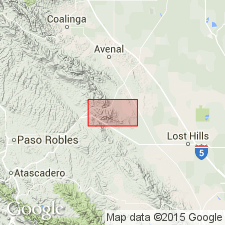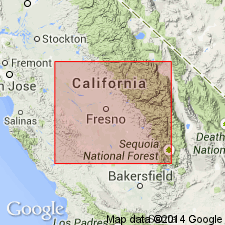
- Usage in publication:
-
- Red Man sandstone
- Modifications:
-
- Original reference
- Dominant lithology:
-
- Arkose
- Conglomerate
- AAPG geologic province:
-
- San Joaquin basin
Summary:
Pg. 7 (fig. 3), 26-28, pls. 1, 2. See also 1956 [abs.], Dissert. Abs., v. 16, no. 1, p. 101. Red Man sandstone. Massive concretionary cavernous-weathering arkose with two thin conglomerates; contains PARAPACHYDISCUS, INOCERAMUS prisms, and foraminifers. Thickness at type locality 1,180 feet. Conformably overlies Moonlight formation (new) in Sawtooth Ridge. Elsewhere is faulted against other units. Underlies Moreno formation. Probably equivalent to Brown Mountain sandstone (Anderson, 1941). Unit has been mapped by some workers as Point of Rocks formation. Age is Late Cretaceous.
Type locality: south limb Devil's Den syncline, Sawtooth Ridge quadrangle, Kern Co., southern CA. About 2 mi northwest of synclinal axis formation crops out in prominent crags which are here named Red Man Rocks.
Source: US geologic names lexicon (USGS Bull. 1200, p. 3223).

- Usage in publication:
-
- [Red Man] Sandstone
- Modifications:
-
- Overview
- AAPG geologic province:
-
- San Joaquin basin
Summary:
zzzzzArea of report is Avenal Ridge-Reef Ridge area of southern Diablo Range, 200 miles southeast of San Francisco, in Fresno and Kings Counties, west-central California. Eight stratigraphic units ranging from Early to Late Cretaceous are recognized in area, in descending [ascending?] order: Badger Shale, Risco Formation, Johnson Peak Formation, Catskin Formation (new), Lovel Shale (new), Redman [Red Man] Sandstone, Willow Spring Mudstone (new), and Moreno Formation. All rocks are marine of shallow neritic to bathyl depths and consist of thick sequences of mudstone, shale, thin- to thick-bedded concretionary sandstones and conglomerates. Unconformities exist between [Red Man] (Campanian) and Willow Spring (Maastrichtian); [Red Man] and Lovel (Santonian); and Lovel and Catskin (Cenomanian to Coniacian).
Source: US geologic names lexicon (USGS Bull. 1350, p. 130, 443, 832); supplemental information from GNU records (USGS DDS-6; Menlo GNULEX).
For more information, please contact Nancy Stamm, Geologic Names Committee Secretary.
Asterisk (*) indicates published by U.S. Geological Survey authors.
"No current usage" (†) implies that a name has been abandoned or has fallen into disuse. Former usage and, if known, replacement name given in parentheses ( ).
Slash (/) indicates name conflicts with nomenclatural guidelines (CSN, 1933; ACSN, 1961, 1970; NACSN, 1983, 2005, 2021). May be explained within brackets ([ ]).

